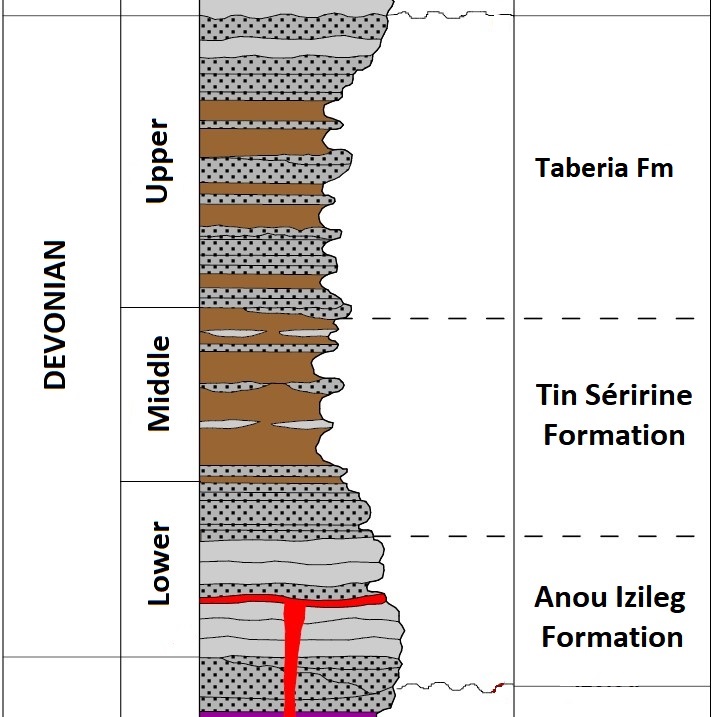Tin Séririne Fm
Type Locality and Naming
Named after the Tin Sérine syncline.
References: Lessard, 1961; Claret & Tempère, 1968; Fabre et al., 1983; Derycke & Goujet, 2011.
Synonym: Tin Seririne Fm. For Akara Member: “Akara Schist” ; “Schistes d’Akara” ; “Argiles à Stylioline”; “Grès de Taberia”, “Grès d’Amesgueur”; Upper Member of the Tin Séririne formation ; Akora Schist (misspelling). Oued Felaou Member was also known previously as “Grès de Touaret” as per Joulia (1959)’s definition.
Lithology and Thickness
Thickness ranges from 150 to 270 m. On page 51 of Valsardieu (1971), it is stated a thickness of 105 m in the area of Touaret.
It is divided into two Members from bottom to top:
- Oued Felaou Mbr: Sandy clays. It begins with a conglomerate level overlaid by fine lumachellic clayey sandstones.
- Akara Mbr (Stylioline Clays): flaky or platelet clays, very rich in Eopteropods, with rare siltstones at the base, more developed towards the top, until forming at the top a mass of 7 m containing lumachellic events with brachiopods. 32 to 264 m, thinner in the west and south. The limestones with brachiopods can be 50 to 80 m thick.
[Figure 1: Devonian lithostratigraphic column in the Tim Mersoï Sub-Basin showing a Lower Devonian dolerite intrusion of the " Complexe Doléritique d'In Debirene Fm " (Modified after Mammar, 2012) which has been dated to Lower Carboniferous (Tournaisian) by Djellit et al. (2006)]
Relationships and Distribution
Lower contact
Underlying unit is the Anou Izileg Fm (Fig. 1)
Upper contact
Overlying unit is the Taberia Fm, which erodes the upper part of the Akara Member locally.
Regional extent
Iullemmeden Basin - Tim Mersoï Sub-Basin
GeoJSON
Fossils
Oued Felaou Mbr yielded Acrospirifer arduennensis, Hysterolites carinatus, Paraspirifer cultrijugatus indicating the Upper Emsian. The silty top of Akara Mbr has Mucrospirifer mucronatus, Hysterolites mediotextus, Spinocyrtia ascendens, indicating Eifelian to Givetian age.
Age
Depositional setting
Marine
Additional Information
